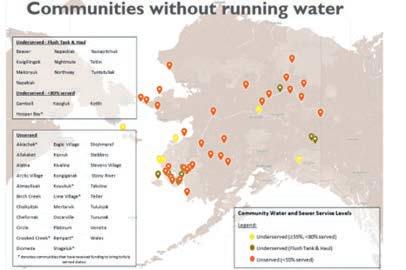
2 minute read
Fighting for Clean Water and Sanitation in Rural Alaska
Based on participants’ contributions, five key themes emerged that will guide the focus and activities of the Initiative’s Arctic Resilience Project going forward: (1) empowering young leaders; (2) prioritizing community ownership, community-driven solutions, and capacity building; (3) building and improving networks and cross-border connections; (4) investing in local innovation; and (5) understanding and communicating Arctic change. “Regardless of how the Arctic states eventually address the diplomatic vacuum created by the shuttering of the Arctic Council, this disruption presents an opportunity to explore novel Indigenousled structures tailored to the needs of a rapidly transforming region.” —Joel Clement, “The Arctic Won’t Wait: Novel Structures for Advancing Arctic Goals During Geopolitical Crisis”
In Alaska, only 67% of households are serviced by public wastewater systems. The latest research from Indian Health Service found thirty-two communities remain unserved, where 45% or more homes have not been served either via pipe, septic tank and well, or covered haul system. An additional fourteen communities are underserved: they have limited water and sewage infrastructure that are badly in need of upgrade and repair. Most of the villages without running water are majority Alaskan Native. This infrastructure deficit leads to environmental contamination, which threatens Alaska Native villages, a threat only heightened by climate change and the COVID-19 pandemic. Lack of access to adequate water and sanitation has significant social, environmental, and health costs. Indian Health Service has found that every $1 spent on water and sewer infrastructure will save $1.18 in avoided direct healthcare costs. On June 28, 2022, the Arctic Initiative and the Alaska Native Health Board hosted a roundtable on community infrastructure development in Alaska. The event brought together representatives from Native health corporations, statewide Native health groups, and the Arctic Initiative to discuss not only how to best use recently allocated federal funds to build critical infrastructure in rural Alaska, but also how to ensure that the construction and operation of said infrastructure is sustainable. The first session focused on the pressing need for the expansion of access to piped water and wastewater collection in rural Alaska, as well as on the opportunities afforded by the passage of the Biden administration’s Infrastructure Investment and Jobs Act. In the Yukon-Kuskokwim Delta alone, shared Brian Lefferts of the Yukon Kuskokwim Health Corporation, a transition to a full pipe system would result in an average of 4,600 fewer people falling ill and 60 fewer people dying of preventable illness every year, remarkable figures in a region with a population of roughly 25,000. The second session, discussion centered on methods of overcoming barriers to sustainable development and operation of infrastructure in the villages. Chris Cox, Business Manager of the Alaska Native Tribal Health Cooperative’s Alaska
Source: Indian Health Service










